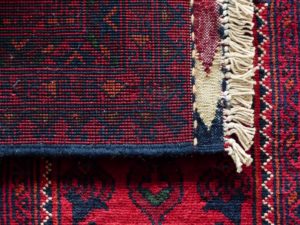The heritage of a place is not defined merely by performing arts; rather, a large chunk of history can be traced through the locally created art of craftsmen. Since time immemorial, local handmade craft was the sole livelihood for communities. They kept their folklore and traditions alive in the imprints and paint on objects that were prepared to survive the test of time. Carpet weaving in the state of Madhya Pradesh is one such art that speaks of rich tradition and culture.

Carpet weaving found its way to Madhya Pradesh on the backs of traders travelling the silk
routes from Persia all the way to the Mughal Empire. With further encouragement and support, Gwalior was transformed into a carpet-weaving centre of excellent reputation. The weavers here were masters in the craft of weaving as well as dyeing. The carpets made by these artisans were not limited to attractive coverings on the floor. Over time, their carpets become the books that told stories of historic times and the heritage of the land. Scenes of war, celebrations, coronations that have intricately marked the local history are some occasions that have been preserved by weaving them on coverings. More than an indelible mark of history, these carpets are the result of familial ties and growing artisan industries.
One of the most famous ways such ties have been depicted in crafts, is through woven carpets- called ‘Dhurries’. Dhurries are essentially woven carpets used as floor coverings. These are available in a variety of designs and are made of thick cotton fabric. The dhurries are made in the most traditional way of weaving. Usually bright coloured, they are saved by hand- operated- looms. Craftspersons dye the yarn according to the design and the combination required to finish the product.
Jajamas or the floor coverings are known all over for their attractive designs. Traditionally
jamas have pinkish- white background and bright red colour designs. The designs are separated by black or bright red colour lines. Artisans work on many kinds of motifs on the jajamas. Some of them have geometric designs, leaves and flowers. The beauty of the craftsmanship showers from the neempati motif which has 24- petal flowers bounded by flowers and leaves. Sun is considered very auspicious and it reflects new life. Sunflower design is another motif which is made purely in yellow colour or as desired by the buyer.
With bright colours and scenic depictions, these art-objects are woven by women at home in various villages and towns of Madhya Pradesh, making it a familial task of subsistence.
Crafts(wo)men, working both alone and with their kin- paining over the weave, the look of the design, the message that is to be carried forward and more importantly, the weight of keeping ancestral flavours alive are a living testimony of how families come together to keep the art of carpet weaving alive. And rightfully so, most of them confess it would be impossible to pull off the herculean task single handedly and hence, their brothers and sons help them in the work.
The art of Carpet Weaving, like any other art form, is changing with the years to provide a
mirror for contemporary society. The entire community is chipping away in the process. The people who use this art for subsistence and livelihood deserve profound credit for sensitively and responsibly translating themes into contemporary designs without diluting their bonds with the vast reserve of ancestral patterns.
Analyzing how and to what extent the lives of people involved in such crafts has changed. This says a lot about the direction that the society has taken both in general and regarding the crafts. Our endeavor should not stop at preserving arts and instead should delve into the oceans that attempt to understand the underlying emotions as well because more than
anything, such arts require assistance and people who appreciate their true worth.
Written by: Kartik Shrotriya


With thanks! Valuable information!
With thanks! Valuable information!
With thanks! Valuable information!